
17 minute read
UPHOLSTERED FURNITURE FRAMES WITH SIDE PLATES FROM PB, OSB AND PLY BY FEM
ACTA FACULTATIS XYLOLOGIAE ZVOLEN, 62(1): 125−132, 2020 Zvolen, Technická univerzita vo Zvolene DOI: 10.17423/afx.2020.62.1.11
DEFORMATION COMPARISON OF UPHOLSTERED FURNITURE FRAMES WITH SIDE PLATES FROM PB, OSB AND PLY BY FEM
Advertisement
Nelly Staneva - Yancho Genchev - Desislava Hristodorova
ABSTRACT
Deformation comparison by the method of finite elements (FEM) of one-seat upholstered furniture frames with rails of pine solid wood (Pinus Sylvestris L.) and side plates of different furniture boards (PB, OSB and PLY) was carried out. Three-dimensional (3D) geometric model of the upholstered furniture frame was created and linear static analyses with CAE system were carried out simulating light-service loading of the frames with different materials of the side plates. The orthotropic properties of the used materials were taken into account in the static analyses. FEAs were performed with regard to experimentally established coefficients of rotational stiffness of used corner joints with staples and PVA’c glue in the frames-case butt joints and end to face butt joints. The distribution of linear displacements and nodal rotations in 3D discrete models of upholstered furniture frames were analyzed. The comparative analysis determines side plates from PLY as the most suitable furniture boards for upholstered frames with side plates concerning their deformation behavior and side plates from PB (16 mm) as the most unfavorable. Results will serve for optimization of design of upholstered furniture frames with staple joints and different materials of side plates. Key words: PB, OSB, PLY, staple joints, upholstered furniture frame, deformation, FEM.
INTRODUCTION
The deformation behaviour of the upholstered furniture frames depends mainly on the physical and mechanical properties of the materials used in their construction. In the past years the wood boards as PB, OSB and PLY are widely used in the furniture practice. KASAL (2006) has recommended this especially in the frames of upholstered furniture.
Limited number of publications on studies of upholstered furniture frames made from PB, OSB or PLY with staple joints are available in the literature: SMARDZEWSKI (2001) has found the optimal solution for a single-seat arm-chair made of wood and chipboard with staples joints; Further, SMARDZEWSKI and PREKRAT (2009) have carried out experimental and numerical studies of two-person sofa frame with plates from PB and beam elements from pine and beech wood taking account of orthotropic properties of the materials. Proposingnew dimensions of the frameelements the authors have not established significant change of the construction rigidity; Three-seat sofa frame made entirely of OSB has been investigated byWANG (2007) using SAP 2000. She has modeled 3 different models by beam finite elements with two types of connections (rigid and semi-rigid) and two types of connectors (screws and metal plates; staples and metal plates). Wang has established the
most appropriate configuration of the sofa frame from OSB under light, medium and heavy loads and has established that the type of connectors does not change the displacements remarkably; ERDIL et al. (2008) have investigated 3-seat upholstered furniture frames made of OSB, yellow birch dowels and PVA, and also Douglas-fir and sweet gum plywood using the simplified methods of structural analysis. They have concluded that these materials may be used in upholstered furniture frames to meet specific design loads.
Preliminary investigations of the deformation behavior of upholstered frames with rails from pine solid wood and side plates of PB, OSB and plywood at light-service load have been carried out from STANEVA et al. (2018a, b, c) and GENCHEV et al. (2018) using FEM. Comparing the deformation behavior of upholstered frames with these materials STANEVA et al. (2018d) have established that in the field of assembling of the rear rail of the seat and in the base of the side plates the resultant linear displacement is greatest for the side plates form PB, 35% smaller for side plates from OSB and 62% smaller for PW in the field of the rear rail of the seat and 36% smaller for side plates from OSB and 59% smaller for side plates from PW in the base of the side plates. Next, STANEVA et al. (2019) have performed deformation study by FEM of upholstered frame with side plates from OSB (different producer) with elastic properties other than the previous ones. This necessitated a new comparative analysis of the deformation behavior of upholstered frames with side plates from PB, OSB and plywood.
The goal of this study was to compare the deformation characteristics of one-seat frames of upholstered furniture with side plates of PB, OSB and PLY and staple joints under light-service loading by the method of finite elements (FEM) using CAD/CAE.
MATERIAL AND METHODS
Three-dimensional (3D)model of one-seat upholstered furniture frame with length 600 mm, width 725 mm and height 650 mm was created (Fig.1). The rails 25×50 mm are from pine solid wood (Pinus Sylvestris L.) and side plates from PB, OSB and PLY. Two 3D discrete models of the side frame with plate finite elements were created - without (model A) and with strengthening details under the rails of the seat (model B) – Fig.1. The generated Midplane mesh has 5130 plate finite elements and 33616 DOF's for model A and 5230 plate finite elements and 34096 DOF's for model B. A linear static analysis of each 3D discrete model (A and B) of the upholstered furniture frame with PB, OSB and PLY side plates was carried out with CAE system Autodesk Simulation Mechanical® by FEM.
Orthotropic material type was introduced in the program:
For rails and strengthening details: Scots pine (Pinus sylvestris L.) with measured density 431 kg/m³ (BDS EN 323:2001) and elastic characteristics: Ez = EL = 9000·106 N/m2 , Ex =ET=593·106 N/m2 , GLT =554·106 N/m2 , LR=0.03, LT=0.027, TL=0.41, RL=0.49.
For side plates:
Particleboards (PB) with thickness 16 mm and characteristics: measured density 678 kg/m³ (BDS EN 323:2001); Ex =E=2700·106 N/m2 and Ey = E//=1600·106 N/m2; Poisson ratios xy = 0.30 and yx = 0.18 according BODIG et al. (1982). Oriented strandboard (OSB), type OSB2 (BDS EN 13986:2004) with thickness 15 mm and characteristics: measured density 596 kg/m³ (BDS EN 323:2001); Eх =E//= 3500·106N/m2; Eу =E=1400·106 N/m2; xy=0.30 according to THOMAS (2003) and yx= 0.24, calculated according to BODIG et al. (1982):
xy Ex yx Ey , (1)
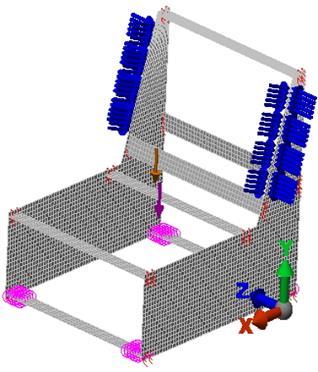
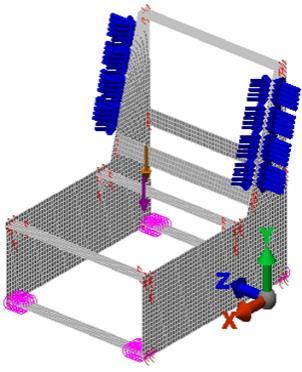
Fig. 1. Discrete models A and B of upholstered frame.
Plywood (PLY) boards from birch (Betula) with thickness 15 mm, 11 layers (BDS EN 14279:2004) and characteristics: measured density 629 kg/m³ (BDS EN 323:2001); Ex =E//=7224·106 N/m2; Ey =E=5709·106 N/m2; xy=0.30 according to BODIG et al.(1982) and yx=0.237, calculated from equation 1.
Boundary conditions were set: bottom front rail – no translation on у direction and bottom rear rail no translation on х, у- and z direction – Fig.1.
Semi-rigid connections between rails and side plates of the frame were simulated: narrow zones were modeled with established via tests by FEM lower modules of elasticity of the used materials in the place of joints according to the methodology of МARINOVA (1996); The experimentally established and calculated by HRISTODOROVA (2019) coefficients of rotational stiffness of the corner joints with two staples and PVA’c glue, loading under compression, were introduced in the nodes of the respective corner joints case butt joints (for pine-PB с = 1017 N·m/rad; for pine-OSB с = 1482 N·m/rad; for pinePW с = 1788 N·m/rad;) and end to face butt joints (for pine-PB с = 823 N·m/rad; for pineOSB с = 844 N·m/rad; for pine-PW с = 1433 N·m/rad;).
Eachdiscrete framemodel was loaded with a total load of 800N, distributed as follows (Fig.1): 80% were set as a remote force, distributed between rails of the seat with application point of 100 mm in front of the rear rail; 16% were set as equal nodal forces, distributed on the edges of the two sides of the backrest.
More details and validity of this approach are given in STANEVA et al. (2018d).
RESULTS AND DISCUSSION
The results for linear displacements (resultant ures, x, y- and z-displacement: ux, uy, uz), nodal rotations (resultant θres, x-, y- and z-nodal rotation: θx, θy, θz) andequivalent strains (maxPR, minPR) for the side plates of the frame for models A and B and for all investigated materials are shown in Table 1 and in Fig.2 to Fig.9. The main differences in the deformation behavior of the investigated frames are mainly expressed in the frame side plates from different materials, so the results for the side plates are only shown.
For both models (A and B) and for all investigated materials the maximum resultant linear displacement (ures) in the side plates was established in their base: in model B it is greater approximately 1.8 times for side plates from PB, 2.3 times for OSB and 1.6 times for PLY than the same in model A (Table 1). Dissolution in the base of side plates for model B was established due to the redistribution of the load, but differences of the linear displacements (in absolute values) are not significant: 0.35 mm for side plate from PB, 0.27 mm for OSB and 0.11 mm for PLY. The maximum resultant linear displacement in
Tab. 1 Maximal values of linear displacements and nodal rotations for side plates.
Parameter Location PB A B
ures.10-3 , [m] base front rail rear rail backrest 0.419 0.767 0.130 0.088 0.180 0.127 0.144 0.152
uy.10-3 , [m] front rail rear rail 0.126 0.080 0.164 0.110
θres, [°] front rail rear rail 0.37 0.22 0.65 0.46
OSB A B
0.211 0.480 0.153 0.076 0.190 0.105 0.133 0.157 0.179 0.033 0.182 0.076
0.,44 0.19 0.,67 0.37
PLY A B
0.199 0.314 0.051 0.036 0.085 0.048 0.062 0.054 0.050 0.031 0.058 0.280
0.19 0.11 0.35 0.26
θy, [°] rear rail 0.20 0.25 0.62 0.148 0.10 0.10
maxPR, [m/m] front rail 0.00827 0.00514 0.01330 0.00197 0.00373 0.00176
minPR, [m/m] front rail rear rail
- -0.00869 -0.00222 0.00740 - 0.00154
- 0.00123 -0.00349 -
the side plate from PB is greater almost 2 times than that of side plate from OSB and PLY for model A and 1.6 times than that of side plate from OSB and 2.44 times than that of side plate from PLY for model B. The maximum resultant linear displacement in the side plates is determined mainly by the linear z-displacement (uz) – Fig.2 and Fig.3.
Another relatively high value for resultant linear displacement and z-displacement in the side plates was observed in model A in the field of rear rail of the seat for PB and PLY, as for OSB it is in the backrest; in model B relatively high value for resultant linear displacement and z-displacement is established in the field of the backrest for all materials Table 1, Fig.2 and Fig.3.
The maximum linear x-displacement (ux) in the side plates from PB was established upper in the backrest for both models A and B, as for side plates from OSB and PLY the maximum values for both models A and B were observed in the field of assembling of the front rail (Fig.4 and Fig.5). For model A the maximum linear x-displacement in the side plate from PB in the field of front rail is almost equal with that of side plate from OSB and 2.9 times greater than that of PLY. For model B the maximum linear x-displacement in the field of front rail is greatest in the side plate from PB, 1.5 times greater than that of side plate from OSB and 2.9 times than that of side plate from PLY.
The maximum resultant nodal rotation θres in the side plates was received in the field of assembling of rear rail of the seat for both models A and B and for all materials (Table 1). It is determined mainly by x-nodal rotation (Fig.6 and Fig.7). In model A the maximum resultant nodal rotation is approximately equal for side plates from PB and OSB and 1.9 times greater than that of side plate from PLY. In model B it is greatest for side plate from PB and 1.2 times greater than that of side plate from OSB and 1.8 times than that of PLY.
The maximum x-nodal rotation (θx) in the field of assembling of rear rail to the side plates from PB is equal with that of side plate from OSB and 1.8 times greater than that of PLY for model A (Fig.6). For model B the maximum x-nodal rotation in the side plates from PB is greatest, 1.3 times greater than that of side plate from OSB and 1.7 than that of PLY (Fig.7). The area with higher values of x-nodal rotation in the side plate is bigger in model B than that in the model A, due to the assembling of strengthening details under rails of the seat.
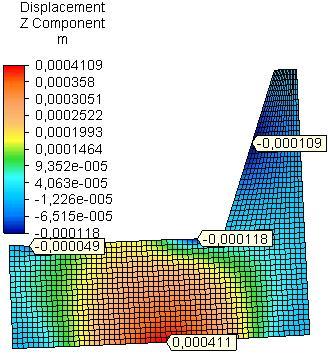
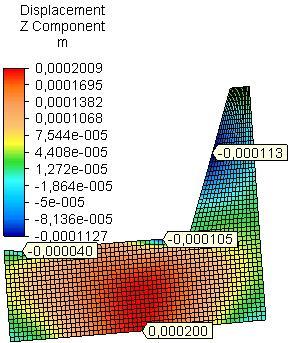
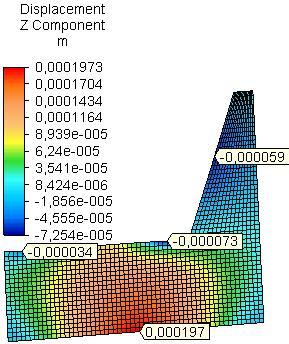
Fig. 2 Distribution of linear z-displacement in side plates from PB, OSB and PLY (model A).
Fig. 3 Distribution of linear z-displacement in side plates from PB, OSB and PLY (model B).
Fig. 4 Distribution of linear x-displacement in side plates from PB, OSB and PLY (model A).
Fig. 5 Distribution of linear x-displacement in side plates from PB, OSB and PLY (model B).
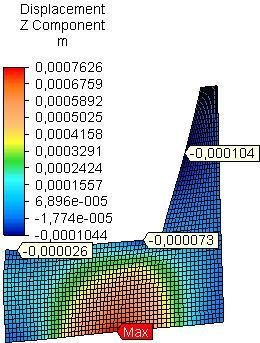
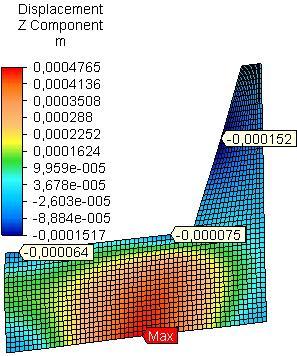
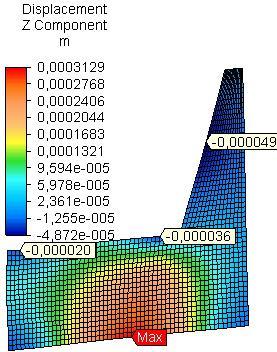
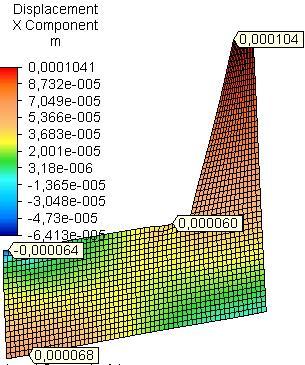

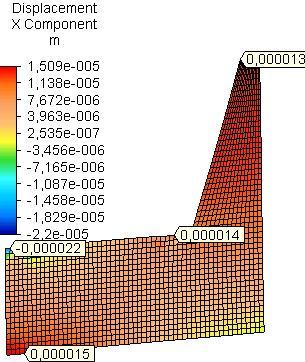
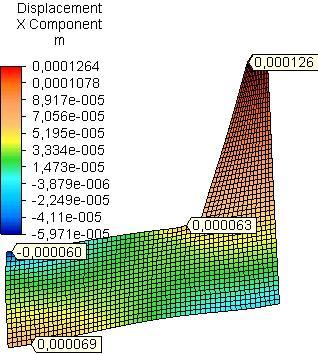

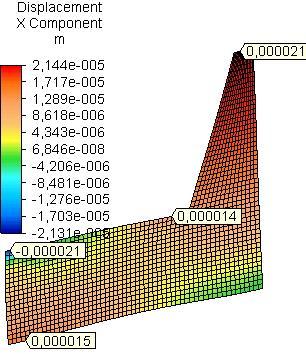
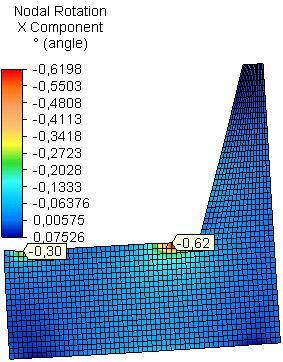

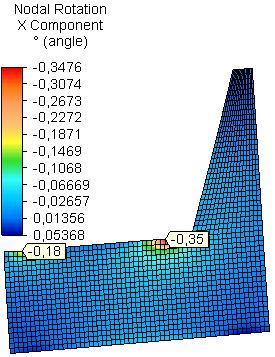
Fig. 6 Distribution of x-nodal rotation in side plates from PB, OSB and PLY (model A)..
Fig. 7 Distribution of x-nodal rotation in side plates from PB, OSB and PLY (model B)..
Fig. 8 Distribution of z-nodal rotation in side plates from PB, OSB and PLY (model A)..
Fig. 9 Distribution of z-nodal rotation in side plates from PB, OSB and PLY (model B)..
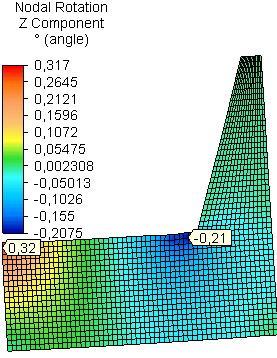

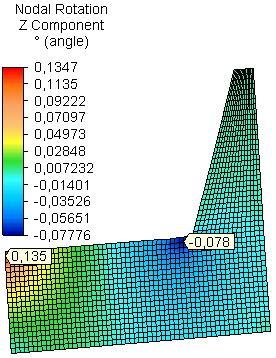
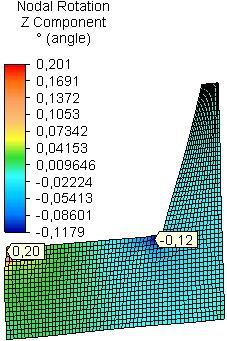
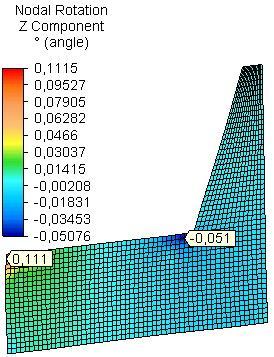
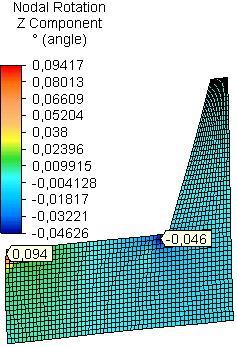
The maximum z-nodal rotation (θz) in the side plates was received in the field of assembling of front rail of the seat for all materials in both models A and B (Fig. 8 and Fig. 9). In model A the maximum z-nodal rotation in the side plates from OSB is greater 1.3 times than that of PB and 3.0 times than that of PLY. For model B the maximumvalue was received for side plate from PB and it is greater 1.8 times than that of side plate from OSB and 2.1 times than that of side plate from PLY.
For all materials of the side plates the maximum value of maximum principal strain (maxPR) was received in the field of assembling of the front rail of the seat for both models A and B (Table 1). In model A for side plates from OSB it is 1.6 times greater than that of side plate from PB and 3.6 times than that of PLY. In model B the maximal value for side plate from PB is 2.6 times greater than that of side plate from OSB and 2.9 than that of PLY.
In model A the maximum value of minimum principal strain (minPR) was established in the field of assembling of the front rail of the seat for side plates from PB and PLY, as in model B the maximum value was established in the field of assembling of the rear rail of the seat for side plate from OSB. For side plates from PB in model A it is 1.2 times greater than that of side plate from OSB and 2.5 times than that of PLY, in model B these relations are 1.4 and 1.8, respectively (Table 1).
It is established that the deformation characteristics of the side plates from used in this investigation OSB boards are better than the same of OSB boards, used in our previous investigations (STANEVA et al. 2018b, d). All the peculiarities of the deformation characteristics of investigated frame side plates are due to the material characteristics of the used furniture boards (PB, OSB and PLY) and especially to the elasticity modules and their orientation in the construction elements of the frame model.
CONCLUSIONS
The maximum resultant linear displacement in the field of the base of the side plate is greatest for the side plates from PB for both models A and B, 50% smaller for OSB and 53% smaller for side plates from PLY in model A, 37% smaller for OSB and 58% smaller for side plates from PLY in model B. Concerning the deformation, the most unstable are the side plates in their base even for strengthened model B for all materials, which is why it is recommended to further strengthen the frame in this area.
In the field of assembling of the rear rail of the seatin the side plate, themaximum resultant linear displacement and the maximum resultant nodal rotation are almost equal (5% and 3% difference) for side plates from OSB and PB in model A. In the same field of the side plate in model B, the maximum resultant linear displacement and the maximum resultant nodal rotation of side plate from OSB are 17% and 20% smaller than that of side plate from PB, respectively.
The side plates from PLY have the best deformation characteristics, that is way PLY boards are recommended as the most suitable furniture boards for the upholstered frame with side plates: in the field of assembling of the rear rail of the seat the maximum resultant linear displacement and the maximum resultant nodal rotation are 5355% and 4648% smaller than that of side plates from PB and OSB for model A; for model B in the same field these characteristics are 5462% and 3043% smaller than that of side plates from OSB and PB.
REFERENCES
BODIG, J., JAYNE, B. 1982. Mechanics of Wood and Wood Composites. New York: Van Nostrand Reinhold Co. Inc, 1982. 711 pp. ISBN 0-442-00822-8.
ERDIL, Y., KASAL, A., ECKELMAN, C. 2008. Theoretical analysis and design of joints in a representative sofa frame constructed of plywood and oriented strand board. In Forest Products J., 58 (7/8): 6267. GENCHEV, Ya., STANEVA, N., HRISTODOROVA, D. 2018. FEM analysis of deformation and stresses of upholstered furniture skeleton made of Pinus Sylvestris and Plywood. In Sci. J. Management and Sustainable Development, 69, (2): 5661. HRISTODOROVA,D. 2019. Stiffness coefficients in joints by staples of skeleton upholstered furniture. In J. Innovation in Woodworking Industry and Engineering Design (INNO), 16 (2): 2733. KASAL,A. 2006. Determination of the strength of various sofa frames with Finite Element Analysis, G.U. In Journal of Science,19 (4): 191203. МARINOVA, А.1996. Methodology of stress and strain furniture structure analysis. In Proceeding of Intern. Sci. Conference "Mechanical Technology of Wood", Sofia, 257267. SMARDZEWSKI, J. 2001. Construction optimisation of upholstred furniture. In Folia Forestalia Polonica, Seria B, zeszyt 32: 519. SMARDZEWSKI, J., PREKRAT, S. 2009. Optimisation of a sofa frame in the integrated CAD-CAE environment. In Electronic J. of Polish Agricultural Universities, 12 (4) Wood Technology. Available online http://www.ejpau.media.pl STANEVA,N.,GENCHEV,YA.,HRISTODOROVA,D. 2018a. Static analysis of an upholstered furniture skeleton with staple corner joints by FEM. In Innovation in Woodworking Industry and Engineering Design (INNO), 14(2): 7885. STANEVA, N., GENCHEV, Ya., HRISTODOROVA, D.; ALEXANDROVA, G. 2018b. 3D modeling and FEM analysis of deformations of a furniture skeleton with OSB side plates. In Chip and Chipless Woodworking Processes. 11 (1): 165–170. STANEVA, N., GENCHEV, Ya., HRISTODOROVA, D. 2018c. Approach to designing an upholstered furniture frame by the finite element method. In Acta Facultatis Xylologiae Zvolen, 60 (2): 61−69. STANEVA, N., GENCHEV, Ya., HRISTODOROVA, D. 2018d. Comparative finite elements analysis of deformations in an upholstered furniture skeleton with side plates from PB, OSB and Plywood. In Proceedings of 29th International Conference on Wood Modification and Technology (ICSWT 2018) „Implementation of Wood Science in Woodworking Sector“, Zagreb: 171184. STANEVA, N., GENCHEV, Ya., HRISTODOROVA, D. 2019.Analysis of deformations and stresses of an upholstered furniture frame with OSB side plates. In Proceeding of 30th Intern. Conference on Wood Modification and Technology – ICWST 2019 „Implementation of Wood Science in Woodworking Sector“, Zagreb, pp.177185. THOMAS, W. 2003. Poisson’s ratio of an oriented strand board. In Wood Sci. Technology, 37 (3): 259268. WANG, X. 2007. Designing, modeling and testing of joints and attachment systems for the use of OSB in upholstered furniture frames, PhD thesis, University Laval, Quebec. 264 pp. Available online: http://archimede. Bibl.unival.ca/archimede/fichiers/24743/24743.pdf
AUTHORS’ ADRESS
Nelly Staneva, PhD. University of Forestry Faculty of Forest Industry Department of Furniture Production 1797 Sofia, Bulgaria nelly_staneva@yahoo.com










